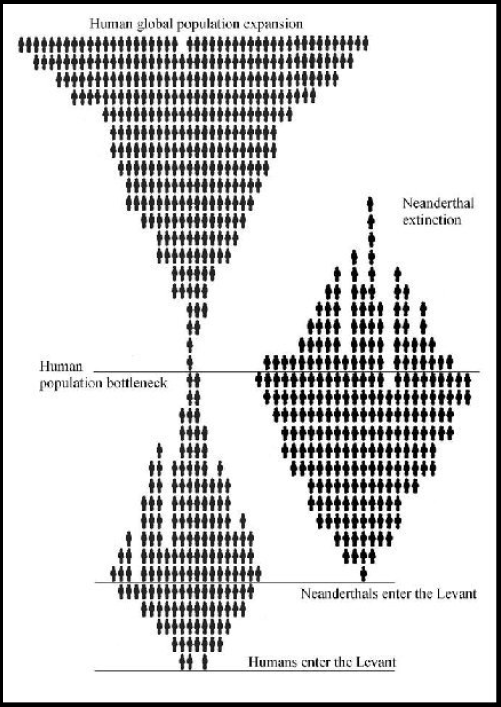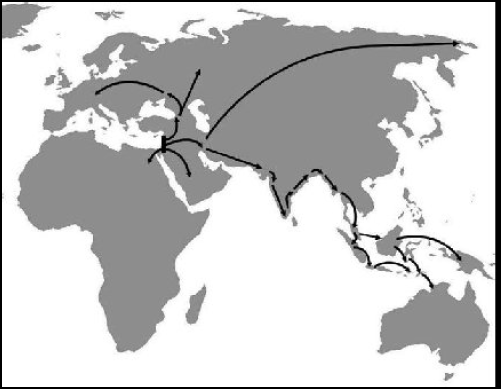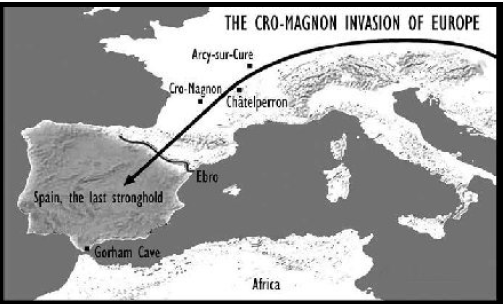extermination, 9
There is reason to believe that hyper-aggression included a sexual component. I proposed earlier that one method of achieving hyper-aggression in young Cro-Magnons males was by selecting for extremely elevated levels of serum testosterone. Testosterone also happens to be the primary male sex hormone, elevated levels of which predisposes increased sexual arousal and activity. This means that, not only were Cro-Magnon men hyper-aggressive compared to modern humans, they were almost certainly hyper-sexual as well.
If Cro-Magnon social groups resembled modern hunter-gatherer groups, they would ostensibly congregate in tribes close to fresh water and good hunting grounds. From there, the young men would launch hunting and gathering expeditions, sometimes lasting weeks, or even months. These bands of heavily-armed hyper-aggressive, hyper-sexual young men—genetically charged with a bevy of powerful hormones—posed a threat not only to Neanderthals but to other human populations.
As a hunting and fighting group, the Cro-Magnon men depended on each other for their survival. They hunted, fought, suffered and died together. And doubtlessly they celebrated their victories together. These emotionally shared experiences would create an indelible bond between the men, far more intense than today’s male bonding of football teams and fishing buddies. For Cro-Magnons, male bonding was not just social, it was a life and death issue. As such, it was a functional adaptation that directly contributed to their survival and reproductive success.
Also deeply ingrained in the Cro-Magnon psyche was the concept of them and us. For them, it represented more than a species divide. It was a life and death distinction, adaptive because it was plain and simple enough for them to understand at a visceral, intuitive level. It had almost nothing to do with rational thought and objective reasoning and everything to do with gut instinct—innate prejudices, sex and violence and deeply entrenched them and us mindsets.
There was no precise intellectual concept of them. The description applied to almost anyone and anything outside the group. Any mix of sex and violence could be meted out without the slightest remorse to anyone branded ‘them’. The Cro-Magnons were probably the most psychopathic humans who ever lived—but they were creatures of their time. With a job to do. And if they had not done their job, none of us would be here.

After the population bottleneck, the human population expanded and the Eurasian Neanderthal population plummeted towards extinction.
The first genocide
From a broader sociological perspective, it is immediately apparent what these nomadic bands of hyper-aggressive, hyper-sexed Cro-Magnons were doing. They were practising genocide. It was undirected, haphazard and certainly inefficient by today’s standards, but it was highly motivated. And over a few thousand years, the Cro-Magnons drove the Eurasian Neanderthals to extinction.
The genocide hypothesis fits with sociological studies of lethal aggression by male coalitions (modern armies) and with a long history of human warfare, xenophobia and genocide. In The Descent of Man, Charles Darwin has this to say on the propensity of humans to kill off those they considered inferior:
All that we know about savages, or may infer from their traditions and from old monuments, the history of which is quite forgotten by the present inhabitants, shew that from the remotest times successful tribes have supplanted other tribes.
More importantly, the theory that humans annihilated the Eurasian Neanderthals is consistent with the fossil record of the Levant that shows the Neanderthals disappeared just after the first appearance of the first Upper Palaeolithic humans in the Levant.
John Shea says:
Throughout Western Eurasia, the end of the Middle Palaeolithic period marks the last appearance of Neanderthals in the fossil record. Between 30–47 Kya, Upper Palaeolithic humans expanded their geographic range to include all the territory formerly occupied by the Neanderthals and other anatomically archaic humans. The Middle Palaeolithic period in the Levant was the last period in which modern humans had serious evolutionary rivals for global supremacy.
NP theory goes even further, predicting that a genocidal war took place, that it was successful, and that it was relatively quick. Why? Because the Cro-Magnons were not only militarily much more advanced than the Eurasian Neanderthals, they were socially bonded into a single massive military group that can only be described as an army—or at the very least a proto-army. This was the strategic application of the new socialisation process—a process that effectively united the disparate tribes of Syria, Israel, Palestine, Jordan and other areas of the Levant into a single combative force that swept all before it.
As the raggle-taggle proto-army grew, a tipping point was reached, and the tide began to turn. The Cro-Magnon campaign accelerated its onslaught into a blitzkrieg. Over time, this search and destroy operation became genetically encoded in testosterone-charged adolescent and young adult males and continued unabated—generation after generation—until not a single Neanderthal was left alive from northern Turkey to Egypt.
This view is supported by the archaeology. John Shea concludes in Modern Human Origins and Neanderthal Extinctions in the Levant, “that around 45,000–35,000 BP, Neanderthal fossils cease to occur in the Levant at exactly the point when Upper Palaeolithic industries first appear in Israeli and Lebanese cave sites.”
At the Amud Neanderthal cave, northwest of the Sea of Galilee in Israel, for instance, materials dated from the lowest levels of the cave reveals that Neanderthals first occupied the site 110,000 years ago (±8,000 years). The youngest date measured at the site comes from a single tooth from Level B1/6 which tells us the occupation ended 43,000 years ago (± 5000 years).
Until recently, it was generally assumed that the disappearance of Eurasian Neanderthals from the Levant was caused by a deterioration in the climate. But in April 2008, at a meeting of the American Association of Physical Anthropologists, Miriam Belmaker from Harvard University deftly demonstrated that the climate in the Levant at the time of their extinction was stable, ruling out climate change as a factor in their disappearance.
Power plays and mind games
If NP theory is correct and Cro-Magnons were a hyper-aggressive new transitional species, purpose-built by natural selection to kill Neanderthals, then it follows that even after the disappearance of the last Neanderthal, Levantine males would simply disperse further afield in search of more victims. They had spent several thousand years relentlessly hunting their ancestral foe—this is what young Cro-Magnon males did—and they were not going to stop now.
But NP theory and an understanding of human nature also predicts something else happened: the proto-army of the Levant began to fall apart, and ultimately turned against itself.
The alpha males who, by force of strength and aggression, had maintained cohesion within the group became besieged by eager and ambitious young males determined to assume their mantle. Here, I suggest, is the origin of that unique and ubiquitous pattern of human group dynamics, distinguished by male intergroup competition, power plays, political divisions, leadership challenges, Machiavellian intrigues, betrayals, ‘civil war’ and chaos. The techniques that had been so effective in conquering Neanderthals had found a fertile new outlet within Cro-Magnon society.
As the proto-army grew too large to be effectively managed, fed, organised and controlled, secondary leaders (beta males) saw an opportunity. Taking advantage of the increasing frustration, they agitated, conspired and aspired to be alpha males with access to all the fertile females. Leadership challenges became a constant fixture of the times. Retributions for unsuccessful coup attempts were swift and violent, and deposed leaders would be banished or killed. Dissent spread, disorder became the status quo and eventually some beta males broke away or were expelled, taking their warriors and their families with them. These smaller armies then spread out from the Levant to conquer and colonise their own territories.
While this scenario is, at best, informed conjecture, it is supported by the genetic and archaeological evidence, which reveals the Levant human population did split into at least three large groups that eventually dispersed out of the Levant at precisely that time.
One group migrated east, around the coast of India into eastern Asia, and eventually across the Bering Plain (Beringia) to people the Americas.
A second group dispersed from the Levant to Europe, while a third migrated back to Africa. These migrations all date to between 45,000 to 40,000 years ago.
Suggesting that the third group of Levantine humans migrated south into Africa—their ancestral homeland—is at odds with the long-held assumption that the world-wide dispersal of modern humans began in Africa. Corroborative evidence for the back migration theory only emerged in December 2006, via a landmark study of mitochondrial DNA from ancient human fossils by an international team of 15 geneticists lead by Antonio Torroni from the University of Pavia in Italy. The study, published in Science, reports that between 40,000 to 45,000 years ago, a group of modern humans living in the Levant split into genetically separate groups. Torroni traces one group as it moved north into Europe, and another that moved back to Africa.

The global expansion of modern humans began in the Levant and dispersed to Europe, Africa, Asia, Australia and the Americas, via a coastal, island-hopping route.
By measuring the amount of genetic diversity in the mtDNA and on the Y (male) chromosome, Torroni’s group concludes, “the first Upper Palaeolithic cultures in North Africa (Dabban) and Europe (Aurignacian) had a common source in the Levant”, spreading by migration from a core area in the Levant.
The Upper Palaeolithic Levantine people that Torroni refers to (that first appeared 46,000 to 45,000 years ago) dispersed to south-eastern Europe via Turkey around 43,000 years ago.
The date of the dispersal from the Levant (45,000 to 40,000 years ago) agrees with the near-extinction hypothesis of NP theory and the emergence of a new human species as a consequence of Neanderthal predation.
The pace of this dispersal fits with my more nuanced view that Cro-Magnons, unlike their Middle Palaeolithic predecessors, were not averse to risk-taking, exploration or territorial expansion. It also supports NP theory’s proposal that the incursion into Europe was not a nonchalant nomadic migration in search of hunting and gathering opportunities, but a militaristic blitzkrieg by hyper-aggressive males inherently confident of their colonising and military capabilities. This indication of a new ‘conquistadorial’ component of human nature creates the impression that Cro-Magnons believed their technological and psychological superiority made them invincible—that nothing and no one could stand in their way. This was the first example of military expansionism, and it set the stage for the first real world war.
Chapter 20: The invasion of Europe
In Europe, the Cro-Magnons encountered the European species of Homo neanderthalensis for the first time. The narrative history of the two species proposed by NP theory predicts an inevitable outcome of this interaction: that from around 44,000 years ago, when they first entered Europe from the east, hyper-aggressive Cro-Magnon males threw themselves into a protracted campaign against a well-entrenched (and much larger) population of European Neanderthals. This first successful incursion into traditional Neanderthal territory had all the hallmarks of an invasion. Its intention was nothing less than the complete eradication of Neanderthals from their ancestral homeland.
The archaeology shows that the euphemistically named ‘replacement’ began in the east and progressed in a westerly direction across continental Europe. The first Neanderthals to be replaced by Cro-Magnons were living in Eastern Europe, followed by those in France, Greece, Italy and finally Spain.
What the fossil record and carbon dating agree on is that in every individual case of replacement, the Neanderthals disappear from the fossil record only after modern humans have moved into their territory. Even though Neanderthals had survived in Europe for over 300,000 years—often in the most extreme climatic conditions—it was only once Cro-Magnons occupied their territory that they disappeared. In other words, Cro-Magnons swept across Europe in an east-west direction and Neanderthals became extinct in the same east-west direction at exactly the same time.

Although isolated regional populations of European Neanderthals survived in mountainous regions of Croatia and the Caucasus until about 29,000 years ago, the last remaining Neanderthals appear to have been pushed down the Iberian peninsula to Gibraltar on the southern tip of Spain.
This is not to say that the European Neanderthals were a pushover. They were a well-entrenched, formidable adversary, with exceptional hunting and tracking skills, knowledge of the terrain, superior physical strength and indomitable courage. And they were now fighting for their lives. The fact that the replacement began around 44,000 years ago and took 20,000 years to complete suggests the European Neanderthals put up one hell of a fight.
Another factor that almost certainly contributed to the protracted nature of the conflict was the size of the Neanderthals’ territory. When Cro-Magnons from the Levant invaded Europe, they could have had no idea that the enemy occupied an area of 10 million square kilometres. And in the Late Pleistocene, a few hundred thousand Neanderthals could easily disappear for long stretches, particularly in the forests and mountains, avoiding contact with the intruders.
____________
N.B. You can read the first 35 pages of Vendramini’s book here.